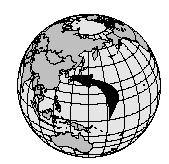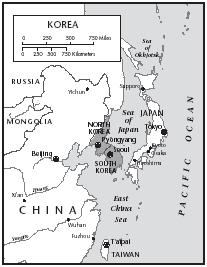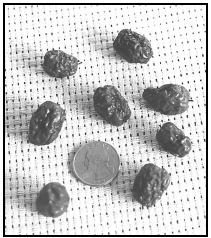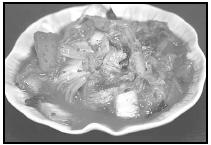Korea
Recipes

1 GEOGRAPHIC SETTING AND ENVIRONMENT
The Korean Peninsula is a large finger of land that extends south from the northeastern border of China into the ocean parallel to Japan. It is surrounded by the Sea of Japan and the East China Sea. Until World War II (1939–1945), Korea was a single country. After World War II, Korea was divided in half to form the Democratic People's Republic of Korea (known as North Korea) with a communist form of government, and the Republic of Korea (known as South Korea) with a democratic form of government.
Both North Korea and South Korea have problems with air and water pollution, and both governments have passed laws to control pollution. Higher elevations are found in North Korea, while South Korea has fertile plains suitable for agriculture in its southern region. The climate supports agriculture, and South Korea grows enough rice to support its population. The main rivers, the Han and the Kum, help to provide adequate water supply for the agricultural lands.
2 HISTORY AND FOOD
Since the country was divided into North Korea and South Korea, the government of North Korea has not welcomed outsiders. Because of this, information about its food and the cooking style of its people is not readily available. Most of the descriptions and recipes included here come from South Korea, although the same foods are probably enjoyed by North Koreans and people of Korean descent living anywhere in the world.
The seas surrounding the Korean peninsula—the Yellow and East China seas, and the Sea of Japan—provide not only many types of seafood, like tuna, king crab and squid, but moisture for the fertile soil needed to grow rice and grains.
For centuries, the Koreans have eaten the products of the land and sea. They began

Chinese and Japanese invasions during the fourteenth through twentieth centuries gave rise to a culinary influence on Korea that remains today. Like the Chinese and Japanese, Koreans eat rice with almost every meal and use chopsticks. Eating with chopsticks means the food is usually cut up into little pieces that are easy to pick up. Food cut this size cooks fast, which cuts down on the use of fuel.
Unlike China and Japan, however, Korea was never a tea-drinking nation. Historically, China and Japan had to boil their water for it to be fit to drink. Korea's water was pure, which led them to discover other beverages, such as ginseng and ginger drinks (made from herbs of the same name), wines, and spirits. Soo Chunkwa (ginger drink) is often served on joyous occasions during the winter, and especially at New Year's.
Soo Chunkwa (Ginger Drink)
Ingredients
- ½ pound ginger (the actual root, not powdered)
- 10 cups cold water
- ¾ pound dried jujubes (red dates used in sweet dishes), or substitute brown dates
- 1 jar (16-ounce) of honey
- Pine nuts (can be found at the local supermarket)
- Cinnamon
To prepare jujubes
Note: This step applies only if jujubes are being used. Skip this step if using dates.
- Wash the jujubes under cold running water.
- Place them in 4 cups of water and bring it to a boil. Cook for 30 minutes. Cool to room temperature.
Procedure
- Wash, but do not peel the ginger.
- Slice it paper-thin.
- Place the ginger in a large pot and add 10 cups cold water.
- Bring to a boil, lower heat, and simmer for 2½ hours.
- Scoop out all of the ginger with a slotted spoon and throw it away.
- Heat the ginger water to boiling again, and add the honey.
- Boil on high heat for 5 to 10 minutes or until the honey has been completely dissolved.
- Let the ginger water cool to drinking temperature (just warm).
- Place a jujube (or date) at the bottom of each glass.
- Add the ginger water; top each glass with 2 pine nuts and sprinkle with a dash of powdered cinnamon.
Makes about 10 servings. Soo Chunkwa will keep, refrigerated, for a few days.
3 FOODS OF THE KOREANS
Korea shares many similarities with other Asian cuisines such as the importance of rice and vegetables and cooking methods such as stir-frying, steaming, and braising (food first browned in oil, then cooked slowly in a liquid). As is true of the rest of Asia, Koreans eat far less meat than people in the Western world. Red meat is scarce and very expensive, so it is usually saved for special occasions. Chicken or seafood is more commonly eaten.
Korean food is often very spicy. Red pepper paste, green onion, soy sauce, bean paste, garlic, and ginger are just some of the many seasonings Koreans use to flavor their dishes. The food is served with a bland grain such as rice to cool the heat of the spices.

The Korean way of preparing and eating their dishes makes for healthy eating. Generally speaking, Koreans are thin people. Being overweight is considered a sign of wealth and dignity and seen particularly among the rich, and high officials.
A meal served for a group of people often includes several large dishes and as many as twenty side dishes. Unlike other Asian cuisines, Korean cuisine includes many uncooked vegetables served in the form of salads and pickles. Traditional Korean meals include soup, served hot or cold depending on the season, like kamja guk (kahm-jah gook; potato soup), and hin pap (heen pop; white rice).
Kamja Guk (Potato Soup)
Ingredients
- 2 cans beef or chicken broth
- 2 large potatoes, peeled and cut into bite-sized pieces
- 2 medium carrots, peeled and cut into bite-sized pieces
- ½ cup mushrooms, chopped
- 1 green onion, chopped
- Pinch black pepper
Procedure
- In a large saucepan, combine broth, potatoes, and carrots.
- Bring to a boil over high heat, and cover.
- Reduce heat to low and cook for 10 minutes, or until vegetables are tender.
- Add mushrooms, green onions, and black pepper.
- Stir well and cook for 2 minutes more.
- Serve hot.
Kimchi (pronounced kim chee), a common spicy Korean side dish, is considered a national dish. Kimchi comes in a variety of flavors depending on family tradition. The main ingredients are cabbage and radish, which are fermented with red chilies, salt, and other vegetables. Kimjang is the traditional Korean custom of making kimchi in the early winter to prepare for the cold months.

Kimchi
Ingredients
- 1 cup medium cabbage, chopped
- 1 cup carrots, thinly sliced
- 1 cup cauliflower, separated into small pieces
- 2 Tablespoons salt
- 2 green onions, thinly sliced
- 3 cloves garlic, thinly chopped, or 1 teaspoon garlic powder
- 1 teaspoon crushed red pepper
- 1 teaspoon fresh ginger, finely grated, or ½ teaspoon ground ginger
Procedure
- Combine cabbage, carrots, and cauliflower in strainer and sprinkle with salt.
- Toss lightly and set in sink for about one hour and allow to drain.
- Rinse with cold water, drain well and place in a medium-size bowl.
- Add onions, garlic, red pepper and ginger.
- Mix thoroughly.
- Cover and refrigerate for at least 2 days, stirring frequently to mix flavors.
- Allow kimchi to sit for 1 or 2 days to ferment. The longer it sits, the spicier it will become.
Hin pap (heen pop; white rice) remains the main staple and is the biggest crop produced in South Korea. It can be eaten in many different ways. There are ogokbap (boiled rice mixed with four grains), yakbap (a sweet rice dish), and over fifty varieties of rice cakes.
Hin Pap (White Rice)
Ingredients
- 2 cups short-grain white rice (not instant)
- 2⅔ cups water
Procedure
- Pour the rice and water into a deep saucepan, and stir to combine.
- Bring to a boil over high heat.
- Boil, uncovered, for 2 to 3 minutes. Stir.
- Cover pan, reduce heat to low, and simmer rice 20 to 25 minutes, or until all water is absorbed.
- Remove pan from heat.
- Keep covered for 10 minutes.
- Fluff with a fork and serve hot.
Serves 6 to 8.
Other common dishes include kalbi (marinated beef short ribs) and sinsollo (a meal of meat, fish, vegetables, eggs, nuts, and bean curd cooked together in broth).
4 FOOD FOR RELIGIOUS AND HOLIDAY CELEBRATIONS
Traditional Korean holidays have developed under the influence of the seasons, rural agricultural life, and the religions of Buddhism and Confucianism. As of the twenty-first century, traditional holidays still held significant meaning in the daily lives of the Korean people.
Toasted Sesame Seeds
Toasted sesame seeds are an ingredient in many Korean recipes, such as Chap Ch'ae, Ch'o Kanjang, and Shigumch'i Namul.
Ingredients
- 4 teaspoons sesame seeds
Procedure
- Measure sesame seeds into a small frying pan (do not add oil).
- Cook, stirring constantly over medium heat 2 to 4 minutes or until the seeds are golden brown (be careful not to burn).
- Remove the seeds from heat and pour into a large bowl. Crush with the back of a wooden spoon.
The Lunar New Year, or Sol, is the first day of the new year. Koreans traditionally hold a memorial service for their ancestors, after which they perform sebae , a formal bow of respect, to their elders as a New Year's greeting. The day is always celebrated with a bowl of ttokkuk , or rice cake soup. Other popular foods eaten on Lunar New Year are chapch'ae (noodles with meat and vegetables), pindaettok (mung bean pancakes), and sujonggwa (cinnamon flavored persimmon punch). At weddings, yakshik , a sticky rice ball loaded with chestnuts, jujubes, raisins, and pine nuts to symbolize children, is served.
Chap Ch'ae (Mixed Vegetables with Cellophane Noodles)
Ingredients
- 5 dried black mushrooms (button mushrooms, or one small can of mushrooms may be substituted)
- 1 cup hot water
- 4 Tablespoons soy sauce
- 2 teaspoons sugar
- ½ teaspoon garlic, finely chopped
- 4 teaspoons toasted, crushed sesame seeds (see above on how to make)
- 1 boneless, skinless chicken breast cut into bite-sized pieces
- 1 package cellophane noodles (can be found in the supermarket)
- 6 Tablespoons vegetable oil
- 1 large onion, peeled and chopped
- 3 carrots, peeled and cut into medium strips
- 1 cup bean sprouts
- ½ cup fresh spinach, chopped
- 5 teaspoons sesame oil
Procedure
- If using dried black mushrooms, put them into a small bowl and pour hot water over them. Soak for 20 minutes or until soft.
- Marinate chicken: In a medium bowl, combine 2 Tablespoons soy sauce, 1 teaspoon sugar, garlic, 2 teaspoons sesame seeds, and chicken. Set aside.
- Prepare noodles: Heat 3 cups of water to a boil in a large saucepan. Add the cellophane noodles and return to a boil.
- Reduce heat to medium to high and cook uncovered, for 5 to 7 minutes or until soft. Drain the noodles and rinse briefly in cold water. Place in large mixing bowl and set aside.
- Prepare chicken and vegetables: In a large frying pan or wok, heat 1 Tablespoon vegetable oil over high heat for 1 minute.
- Add chicken mixture and fry, stirring frequently, for 3 to 4 minutes or until chicken is white and tender. Remove pan from heat and add chicken to noodles.
- When pan has cooled, wash and dry it completely.
- Heat 1 Tablespoon vegetable oil over high heat for 1 minute. Add mushrooms and cook, stirring frequently, for 1 minute or until soft.
- Repeat with remaining vegetables, cooking each one separately. (It is not necessary to wash and dry the pan between vegetables.)
- Add 2 tablespoons soy sauce, 1 teaspoon sugar, 2 teaspoons sesame seeds and 5 teaspoons sesame oil to noodle mixture and mix well. Serve warm or at room temperature.
Serves 2.
Honoring a family's ancestors is an important part of Korea's heritage. Four generations of ancestors are honored on the day before the anniversary of a person's death. Food is served in dishes with special stands to prevent the plates from touching the table. Food is arranged and combined according to strict ancient customs. For example, at least three different colors of fruits and vegetables are set on the table: red fruits and fish to the east, and white fruits and meat to the west. A special dish that may be served is kujolpan , which is served in a nine-compartment dish. These compartments are filled with nine different kinds of brightly colored meats and vegetables. These foods are wrapped in thin pancakes and eaten at the table.
Another traditional holiday in South Korea is called Yadu Nal , or Shampoo Day, on June 15. Friends and family gather at a stream or waterfall to bathe in the clear water, a ceremony they believe will ward off fevers for the rest of the year. A picnic meal is packed and may include mandu (mahndoo; dumplings), sweet rice cakes, grilled fish or meat, and watermelon.
Mandu (Korean Dumplings)
Ingredients
- ¼ pound ground beef
- 1 cup vegetable oil
- 1 Tablespoon vegetable oil
- ½ small onion, peeled and finely chopped
- ¾ cup cabbage, shredded
- ½ cup bean sprouts
- 1 green onion, finely chopped
- 1½ teaspoons black pepper
- Salt, dash
- 25 wonton wrappers (can be found at a supermarket)
- 1 egg
Procedure
- In a large frying pan or wok, cook meat until brown, mashing with a fork to break into small pieces. Remove meat, using a slotted spoon to drain off fat, and set meat aside in a bowl.
- Once cool, wash frying pan or wok and dry thoroughly.
- Heat 1 Tablespoon vegetable oil over high heat for 1 minute.
- Add onions and cook 2 to 3 minutes or until crisp and tender.
- Add cabbage and continue to cook, stirring frequently until cabbage is crisp and tender.
- Add bean sprouts and green onion, mix well, and cook for 1 to 2 minutes more.
- Remove pan from the heat and drain vegetable mixture.
- In a large bowl, combine meat, vegetables, salt and black pepper and mix well to make the filling.
- Place 1 wonton wrapper on a flat surface and cover remaining wrappers with a damp paper paper towel (not dish towel) so they won't dry out.
- Beat the egg in a small bowl. Brush all 4 edges of the wonton wrapper with the beaten egg.
- Place about 1 Tablespoon of the filling mixture just above the center of the wonton wrapper.
- Fold wrapper in half over filling and press the edges together to seal, forming a dumpling.
- In a large frying pan or wok, heat 1 cup vegetable oil over medium heat for 1 minute.
- Carefully place 6 dumplings into oil with tongs and fry 3 to 4 minutes or until golden brown.
- Turn and fry the other side, 2 to 3 minutes.
5 MEALTIME CUSTOMS
There is little difference in what Koreans eat for breakfast, lunch, or dinner. Breakfast, the biggest meal of the day, may include a cold soup, such as oi naeng guk (oh-ee nayng good; cucumber soup), steamed peppers, and saeng son jon (fish patties). Pulgogi (pool-goh-gee; grilled beef) is one of Korea's best-known meat dishes.
Pulgogi (Korean Beef)
In Korea, Pulgogi is prepared on a small grill at the table.
Ingredients
- 2 pounds beef sirloin
- ½ cup soy sauce
- ½ cup water
- 1 Tablespoon sesame oil
- 1 Tablespoon sesame seed
- 1 Tablespoon garlic powder
- ½ teaspoon ginger
- 3 Tablespoons brown sugar or honey (white sugar may be substituted)
Procedure
- Before beginning, place meat in the freezer for 10 minutes to make it easier to slice. Slice beef as thinly as possible.
- Cut meat slices into bite-sized squares. Lightly score the surface of each square to prevent the meat from curling when cooked.
- Put the meat pieces into a large mixing bowl. Add all the other ingredients, and stir with a wooden spoon to mix everything together.
- Cover the bowl and refrigerate for several hours (at least one hour) to allow the meat to absorb the flavors of the marinade.
- Transfer everything to a large saucepan. Heat over medium-low heat until the mixture begins to simmer. Cover and cook about 30 minutes, until the meat has been thoroughly cooked. Stir every 5 minutes to prevent meat from sticking.
- Serve with rice and kimchi.
Serves 8 to 10.
Ch'o Kanjang (Vinegar Soy Sauce)
Ingredients
- 4 Tablespoons soy sauce
- 3 Tablespoons vinegar
- 1 teaspoon sugar
- 1 teaspoon green onions, finely chopped
- 1 teaspoon toasted sesame seeds (see recipe)
Procedure
- Combine all ingredients in a small bowl. Stir to dissolve sugar.
- Vinegar soy sauce will keep up to a week, covered, in the refrigerator.
Lunch could be kamja guk (kahm-jah gook; potato soup) and mixed vegetables with chap ch'ae (chop-chay; cellophane noodles made from mung bean flour). For dinner, perhaps kalbi guk (kahl-bee gook; beef short rib soup), shigumch'i namul (shee-guhm-chee nah-mool; spinach salad), pulgogi (pool-goh-gee; Korean beef), and steamed chicken is eaten. Of course, all three meals would be served with white rice and kimchi . A good Korean cook will try to include five colors at every meal: red, green, yellow, white, and black. Koreans seldom serve dessert, but often eat fresh fruit instead.
Shigumch'i Namul (Korean Spinach)
Ingredients
- ½ cup water
- 1 pound fresh spinach, rinsed with water
- 2 teaspoons soy sauce
- 1 Tablespoon sesame oil
- ½ teaspoon garlic, finely chopped
- 1 Tablespoon toasted sesame seeds (see recipe)
Procedure
- In a large saucepan, bring water to a boil.
- Add spinach, cover, and reduce heat to medium to high. Cook for 2 to 3 minutes, or until bright green.
- Pour into a strainer. Cool.
- Gently squeeze out excess water with your hands.
- Chop spinach and place in a large bowl.
- Add remaining ingredients and mix well.
- Serve at room temperature.
Serves 6 to 8.
Meals are considered an important event in the day to Koreans and much time is spent in its preparation. In fact, Koreans find eating so important they want to concentrate all of their attention on it, and consider it impolite to talk while eating. They avoid conversation until the end of the meal. At mealtime, the dishes of food are placed in the middle of the table and individual bowls of rice are set in front of each person.
The Korean table setting is much different than the table setting used in the United States. The tables, finished with shiny red or black lacquer, are only 10 inches high. Diners are seated on cushions placed on the floor around the table. Beautiful patterns in mother-of-pearl decorate the tables. When the table is not being used, it is hung on the wall like a picture.
Students carry lunch boxes to school that are quite unlike those of U.S. students. They are little tin boxes with several compartments built into them for chopsticks, rice, dried fish, and other foods. Small children have small chopsticks, and as they grow bigger, they use bigger chopsticks.
For snacks at home, Korean students like to eat fruit, either fresh or dried, and sometimes little cakes made from sugar, honey, dried fruit, and rice flour. They are much less sweet tasting than the cookies and cakes made in the United States. The popular kimchi is always in the kitchen and easy to eat as a snack.
6 POLITICS, ECONOMICS, AND NUTRITION
Almost all Koreans receive adequate nutrition in their diets, with the World Bank reporting that less than 1 percent of the population is malnourished and nearly all have access to adequate sanitation and safe drinking water. Korean farmers grow enough rice to meet the country's needs, and fruit growers produce abundant crops of apples, pears, persimmons, and melons. The main vegetable crops are white radish, known as mu , and cabbage. Both are used in kimchi, the national dish.
7 FURTHER STUDY
Books
Cho, Joong Ok. Homestyle Korean Cooking in Pictures . Tokyo: Japan Publications; New York: Kodansha International/USA through Harper & Row [distributor], 1981.
Duvall, Jill. Chef Ki is Serving Dinner! Danbury, CT: Children's Press, 1997.
Hyun, Judy. The Korean Cookbook. Elizabeth, NJ: Hollym International Corp., 1983.
Loewen, Nancy. Food in Korea . Vero Beach, FL: Rourke Publications, 1991.
Marks, Copeland. The Korean Kitchen: Classic Recipes from the Land of the Morning Calm. San Francisco: Chronicle Books, 1993.
No, Chin-hwa. Traditional Korean Cooking: Snacks & Basic Side Dishes . Elizabeth, NJ: Hollym International Corp., 1985.
Okwha Chung and Judy Monroe. Cooking the Korean Way. Minneapolis: Lerner Publications, 1988.
Web Sites
KidSight. [Online] Available http://203.241.132.91/forkid/food/food_1.html (accessed March 14, 2001).
Korea Insights. [Online] Available http://korea.insights.co.kr/food/index.html (accessed March 14, 2001).
Life in Korea. [Online] Available http://www.lifeinkorea.com (accessed March 14, 2001).
Working Holiday Association. [Online] Available http://www.workingholiday.com/english/index.html (accessed March 14, 2001).
Comment about this article, ask questions, or add new information about this topic: